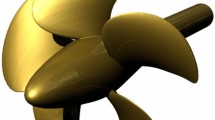Abstract
Numerical simulation is investigated to disclose how propeller boss cap fins (PBCF) operate utilizing Reynolds-averaged Navier-Stokes (RANS) method. In addition, exploration of the influencing mechanism of PBCF on the open water efficiency of one controllable-pitch propeller is analyzed through the open water characteristic curves, blade surface pressure distribution and hub streamline distribution. On this basis, the influence of parameters including airfoil profile, diameter, axial position of installation and circumferential installation angle on the open water efficiency of the controllable-pitch propeller is investigated. Numerical results show: for the controllable-pitch propeller, the thrust generated is at the optimum when the radius of boss cap fins is 1.5 times of propeller hub with an optimal installation position in the axial direction, and its optimal circumferential installation position is the midpoint of the extension line of the front and back ends of two adjacent propeller roots in the front of fin root. Under these optimal parameters, the gain of open water efficiency of the controllable-pitch propeller with different advance velocity coefficients is greater than 0.01, which accounts for approximately an increase of 1%–5% of open water efficiency.
Similar content being viewed by others
References
Gong Qifu, Zhou Heyu (1991). A new type marine energy-saving device-PBCF. Journal of Wuhan University of Water Transportation Engineering, 15(2), 203–210.
Hassan G, Amin M, Abdollah A (2012). Numerical analysis of hub effect on hydrodynamic performance of propellers with inclusion of PBCF to equalize the induced velocity. Polish Maritime Research, 19(2), 17–24.
Hsin CY, Lin BH, Lin CC (2008). The optimum design of a propeller energy-saving device by computational fluid dynamics. The Proceedings of the Fifth Int. Conf. of Computational Fluid Dynamics (ICCFD), Seoul, 655–660.
Hu Zhian, Zhou Hanren (1991). A method of the characteristic calculation and shape decision for propeller boss cap fins. Journal of Hydrodynamics (Ser.A), 6(3), 103–111.
Liu Zhihua, Xiong Ying, Ye Jinming (2007). Study on the prediction of propeller open-water performance using RANS formula and multi-block hybrid meshes. Journal of Hydrodynamic (Ser. A), 22(4), 450–456.
Ma Yan, Xin Gongzheng, Shi Xiaoyong (2011). Numerical evaluation and experimental study of energy saving device-propeller boss cap fins. Shipbuilding of China, 52(Special), 7–18.
Ouchi K, Ogura M (1988). A research and development of PBCF, improvement of flow from propeller boss. Journal of the Society of Naval Architects of Japan, 163(6), 66–79.
Ouchi K, Tamashima M (1989). Research and development of PBCF, new and practical device to enhance propeller efficiency. The 4th International Symposium on Practical Design of Ships and Mobile Units (PRADS), Varna, 125–134.
Qian Xiaonan (1994). Open water test of R-R AB propeller. SJTU towing tank report. Shanghai Jiao Tong University, Shanghai.
Wang Chao, Huang Sheng, Chang Xin (2009). The prediction of hydrodynamic performance of propeller boss cap fins. Ship and Ocean Engineering, 38(6), 20–24.
Wang Chao, Chang Xin, Huang Sheng (2010). Discussion of main parameters influencing assistant thrust efficiency of propeller boss cap fins. Journal of Naval University of Engineering, 22(4), 6–11.
Zhang Zhaoshun, Cui Guixiang, Xu Chunxiao (2005). Theory and modeling of turbulence, Tsinghua University Press, Beijing, 56–65.
Author information
Authors and Affiliations
Corresponding author
Additional information
Foundation item: Supported by the National Natural Science Foundation of China under Grant No. 51079157.
Ying Xiong was born in 1958. He received his PhD degree in Fluid Mechanics from Wuhan University of Technology. He is a professor at Naval University of Engineering. His current research interests include hydrodynamics, design and optimization of marine propulsors.
Zhanzhi Wang was born in 1986. He is a PhD candidate at Naval University of Engineering. His current research interests include ship hydrodynamics and computational fluid dynamics.
Wanjiang Qi was born in 1983. He received his master degree in Naval Architecture and Ocean Engineering from Naval University of Engineering. His current research interests include hull optimization and CFD.
Rights and permissions
About this article
Cite this article
Xiong, Y., Wang, Z. & Qi, W. Numerical study on the influence of boss cap fins on efficiency of controllable-pitch propeller. J. Marine. Sci. Appl. 12, 13–20 (2013). https://doi.org/10.1007/s11804-013-1166-9
Received:
Published:
Issue Date:
DOI: https://doi.org/10.1007/s11804-013-1166-9




